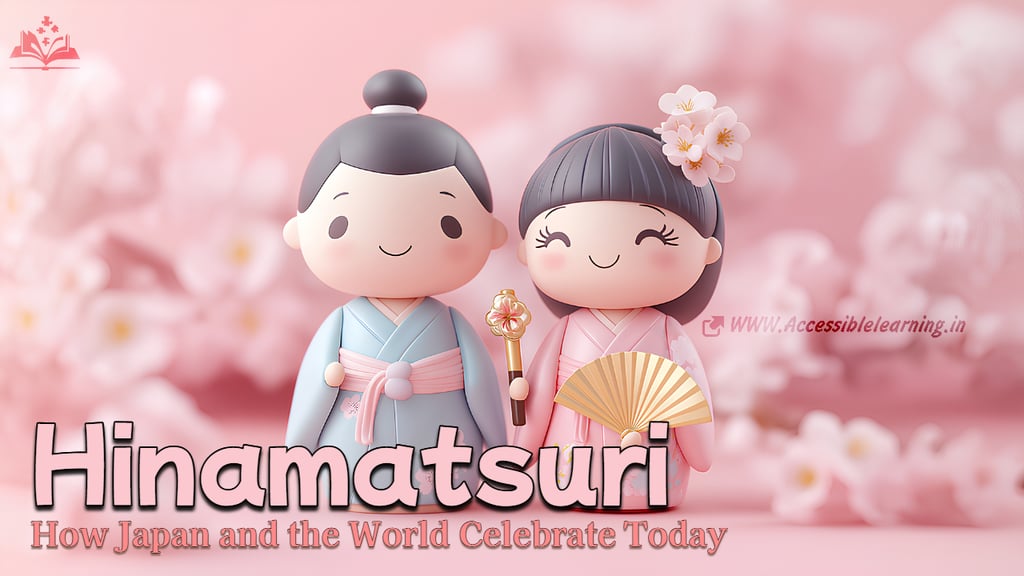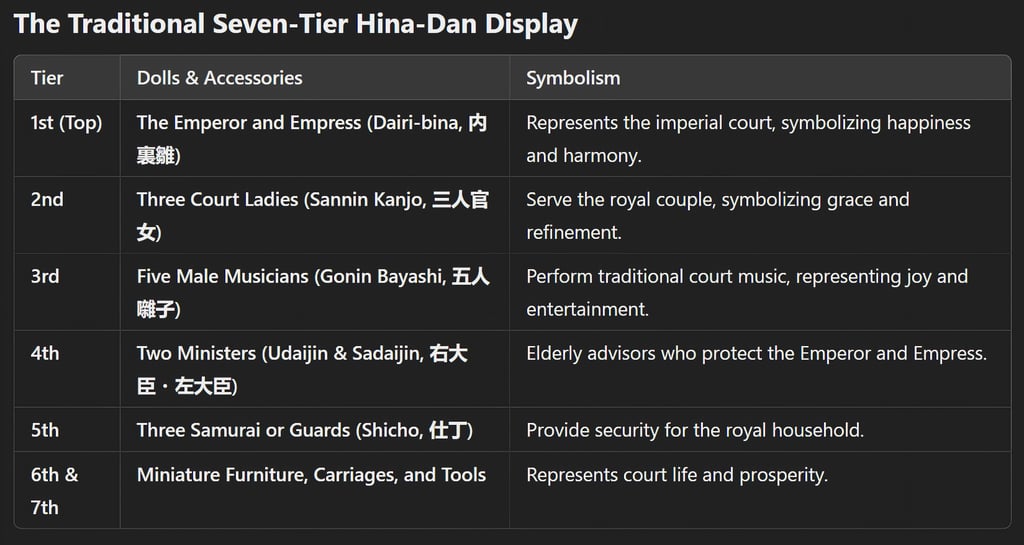
Hinamatsuri in Modern Times: How Japan and the World Celebrate Today
Hinamatsuri (Doll Festival), celebrated on March 3rd in Japan, is a cherished tradition praying for the health and happiness of young girls. Discover its history, hina-ningyō (doll displays), traditional foods, regional variations, and modern adaptations in this in-depth guide.
CULTURE/TRADITIONEVENT/SPECIALCELEBRATION/FESTIVALSJAPAN
Kim Shin
3/2/20253 min read


Hinamatsuri (ひな祭り), or Doll Festival (also called Girls’ Day), is a special occasion celebrated annually on March 3rd in Japan. This festival is dedicated to praying for the health, happiness, and success of young girls, featuring exquisite doll displays, festive foods, and cultural traditions passed down for centuries.
With origins dating back to Japan’s Heian period (794–1185), Hinamatsuri is deeply rooted in history, superstition, and aesthetics. Even in modern times, this festival remains a cherished cultural event, blending ancient customs with contemporary adaptations.
Let’s dive into the history, symbolism, customs, regional variations, and global significance of Hinamatsuri.
The Historical Origins of Hinamatsuri: From Purification to Celebration
Heian Period (794–1185): The Birth of the Tradition
Hinamatsuri’s roots trace back to an ancient Chinese belief that misfortunes could be transferred to objects, particularly dolls. Inspired by this tradition, the Japanese court developed a custom where paper or straw dolls were used to absorb bad luck and then set adrift in rivers or the sea. This practice, known as hina-nagashi (雛流し), or "doll floating," was believed to wash away impurities and ward off evil spirits.
Edo Period (1603–1868): The Evolution into an Elegant Festival
During the Edo period, doll floating gradually transformed into a more decorative practice, as beautifully crafted hina dolls (雛人形, hina-ningyō) became prized artifacts rather than disposable charms. Wealthy families displayed these dolls in elaborate multi-tiered arrangements, reflecting the imperial court of Japan’s Heian era.
This change led to the modern Hinamatsuri, where doll displays became the centerpiece of the festival, shifting the focus from spiritual cleansing to cultural appreciation and family bonding.


The Hina-Ningyō: Symbolism and Arrangement of the Doll Display
A highlight of Hinamatsuri is the hina-dan (雛壇), a stepped platform covered in red cloth (hi-mōsen), where exquisitely dressed dolls are arranged in a specific hierarchy.
(The Traditional Seven-Tier Hina-Dan Display)
Compact and Modern Displays
In modern Japan, smaller hina-dan sets featuring just the Emperor and Empress are more common due to space limitations in urban homes. These compact displays are still considered protective charms for young girls.
Superstitions and Rituals
A crucial belief associated with Hinamatsuri is removing the hina-dan immediately after March 3rd. It is said that leaving the dolls out for too long can curse a girl with late marriage. Many families carefully pack away their dolls right after the festival to avoid this superstition.
Hinamatsuri Traditional Foods: Symbolism in Every Bite
Popular Hinamatsuri Dishes and Their Meanings
Hinamatsuri celebrations feature vibrant, seasonal dishes, many of which have deep symbolic meanings related to health, happiness, and good fortune.
Hina-arare (ひなあられ): Colorful rice crackers in pink, white, green, and yellow, symbolizing the four seasons.
Hishi-mochi (菱餅): Diamond-shaped three-layered rice cakes:
Pink (Protection & Good Health)
White (Purity & Cleansing)
Green (Growth & Fertility)
Chirashi-zushi (ちらし寿司): A festive sushi dish with scattered seafood, eggs, and vegetables, symbolizing prosperity.
Hamiguri Ushio-jiru (はまぐりのお吸い物): Clam soup, where clamshells represent lifelong unity in marriage.
Shirozake (白酒): A sweet, mildly alcoholic rice drink that symbolizes purity and celebration.
Hinamatsuri Regional Variations: Unique Celebrations Across Japan
Different parts of Japan have distinct ways of celebrating Hinamatsuri, reflecting regional traditions and local influences.
Kyoto: Hosts Kyo-Hina Doll Festivals, featuring historical Hina dolls from centuries past.
Tokushima: Known for its Awa Jurobe Yashiki Hinamatsuri, showcasing an extensive Edo-period doll collection.
Tottori: Home to Japan’s largest hina-ningyō collection at the Hina-no-Yakata Museum.
Shizuoka: Features hanging hina decorations called Tsurushi-bina (つるし雛), replacing traditional doll displays.
Coastal Regions: Still practice hina-nagashi (floating paper dolls) as a purification ritual.
These local traditions help preserve Japan’s rich cultural diversity while keeping Hinamatsuri alive across generations.


Hinamatsuri in Modern Times: Adapting to Contemporary Japan
How Japan Celebrates Today
Schools and community centers hold Hinamatsuri-themed events.
Shopping malls set up hina doll exhibitions and offer Hinamatsuri-themed sweets.
Social media trends showcase modern, minimalist hina displays, adapting to urban lifestyles.
Hinamatsuri tourism attracts international visitors, helping spread awareness of this festival.
Hinamatsuri Beyond Japan: A Global Celebration
Due to Japanese diaspora communities, Hinamatsuri is now celebrated in parts of the U.S., Brazil, Canada, and Europe.
Japanese cultural centers host Hinamatsuri exhibits and workshops.
Museums display traditional hina dolls, educating the global audience about this Japanese tradition.
This international recognition has helped preserve and promote Japanese heritage worldwide.
Hinamatsuri is more than just a festival—it represents:
Family traditions, passed from generation to generation.
The preservation of Japanese craftsmanship, seen in exquisitely made hina dolls.
A wish for happiness and success, ensuring young girls grow up healthy, loved, and blessed.
Even as Japan modernizes, Hinamatsuri remains a cherished tradition, proving that some customs truly stand the test of time.
Did you enjoy learning about Hinamatsuri? Share your thoughts below! 🎎✨
Subscribe To Our Newsletter
All © Copyright reserved by Accessible-Learning Hub
| Terms & Conditions
Knowledge is power. Learn with Us. 📚


